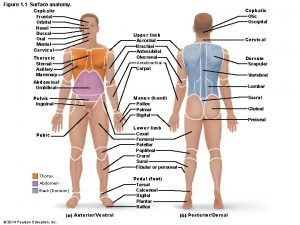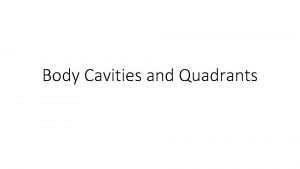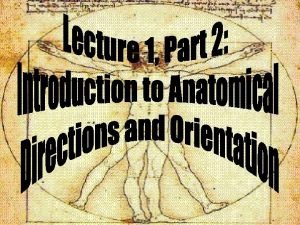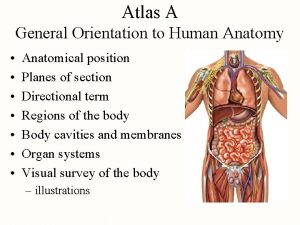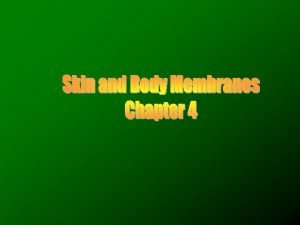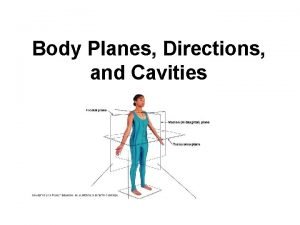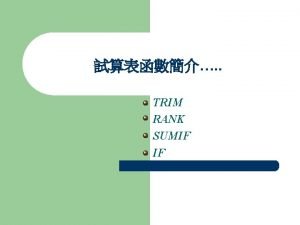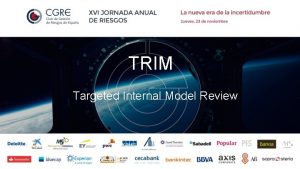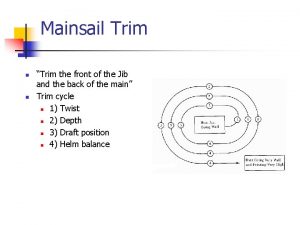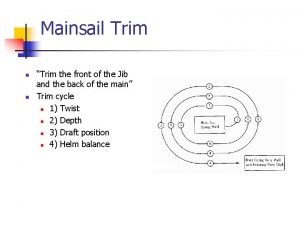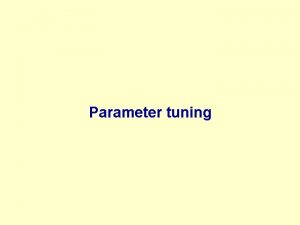DQW LHCseries cavities Discussion Trim Tuning AGENDA Updated



![Target frequencies for DQW SPS-series [1] Measured MHz (Target frequencies updated in Nov. 2017 Target frequencies for DQW SPS-series [1] Measured MHz (Target frequencies updated in Nov. 2017](https://slidetodoc.com/presentation_image_h2/7c1a03a353fcde159219e5efe1ea33ac/image-4.jpg)






![REFERENCES [1] S. Verdú-Andrés, “Target frequencies for a DQW cavity”, EDMS 1569809 v. 3 REFERENCES [1] S. Verdú-Andrés, “Target frequencies for a DQW cavity”, EDMS 1569809 v. 3](https://slidetodoc.com/presentation_image_h2/7c1a03a353fcde159219e5efe1ea33ac/image-11.jpg)

- Slides: 12

DQW LHC-series cavities Discussion: Trim Tuning

AGENDA § Updated target frequency table for DQW SPS-series cavities (Silvia) § Lessons learned from tuning the DQW SPS-series cavities (Silvia) § Target frequency for DQW LHC-series cavities (All) § Jacketed, evacuated, at 2 K, delivering 3. 4 MV to the LHC beam ~ 400. 75 MHz § Strategy (All): § Metrology. § Symmetric trim tuning, or last is asymmetric? § Cavity profile sketch with location of trim edge needed to calculate available trim tuning range § Equipment (Nuria): § Clamp § Probes § Pickup tube § Responsibilities (All): § RI and CERN-BNL responsibilities. § Non-disclosure agreement. S. Verdú-Andrés (BNL) | DQW LHC-series – Discussion: Trim Tuning | Slide 2

MINUTES § Metrology will be provided by RI. § 3 trimming steps, the third being the last one. § Symmetric trim tuning: favor symmetry of the cavity; the two welds are performed after machining if finished, sequentially. § Probes: fabricated by CERN, handled to RI. § RI is responsible for trim tuning. CERN-BNL is a witness with know-how. § Non-disclosure agreement. ACTION ITEMS Silvia -- Generate a target frequency table for DQW LHC-series cavities: q Jacketed, evacuated, at 2 K, delivering 3. 4 MV to LHC beam ~ 400. 75 MHz q Include target frequency for each trimming steps q Correct units and column label (expected measured), update LFD CERN -- Check: q if enough load for tuner; q desired frequency point if tuner breaks to avoid synchro-betatron sidebands (at 3, 8 k. Hz); q LFD for jacketed CERN SPS-series cavity q Cavity profile sketch with location of trim edge needed to calculate available trim tuning range. q Clamp: to be prepared by RI, design to be reviewed by CERN-BNL. S. Verdú-Andrés (BNL) | DQW LHC-series – Discussion: Trim Tuning | Slide 3
![Target frequencies for DQW SPSseries 1 Measured MHz Target frequencies updated in Nov 2017 Target frequencies for DQW SPS-series [1] Measured MHz (Target frequencies updated in Nov. 2017](https://slidetodoc.com/presentation_image_h2/7c1a03a353fcde159219e5efe1ea33ac/image-4.jpg)
Target frequencies for DQW SPS-series [1] Measured MHz (Target frequencies updated in Nov. 2017 from measurements; information from pull-push tuning not included. ) - 4 k. Hz Measured LFD for CERN DQW SPSseries ”bare” cavities with cold test stiffening frame was -350 and -400 Hz/(MV)2 [2], thus -4 k. Hz for 3. 4 MV (Preference to operate tuner in pulling mode to avoid buckling. )

Lessons learned from DQW SPS-series cavities 1) Deformation during last two welds… found method to tune the frequency back. 2) Main frequency shifts: Frequency shift (MHz) Step SPS-DQW-01 SPS-DQW-02 Last two welds +3. 10 +3. 11 BCP +0. 14 +0. 22 High-T baking +0. 07 -0. 001 He tank assembly, welding -0. 42 -0. 57 Coupler insertion -0. 04 -0. 02 Cool down +0. 71 not available 3) Predicted shifts were underestimated and measured shifts have large deviation, but tuning range was sufficient to tune the frequency back. S. Verdú-Andrés (BNL) | DQW LHC-series – Discussion: Trim Tuning | Slide 5

Tuning methods, range Tuning method Trimming Alternative tuning Pre-tuning in tank (at warm) Push-pull tuning Tuning sensitivity (MHz/mm) Minimum frequency step Minimum tuning step Tuning (MHz) (mm) ± 0. 5 (MHz) Increases from 0. 7 to 1. 0 with trimming ± 0. 5 1. 2 -0. 1 0. 77 – 0. 94 (calculated) 0. 318 ± 0. 025 ± 0. 000018 Nb machining -0. 08 ± 0. 025 Control screws ± 0. 00006 range Range limit (mm) (+13, -2) (+9. 2, -2. 0) -2. 4 2. 0 ± 0. 684 ± 0. 508 (at cold) S. Verdú-Andrés (BNL) | DQW LHC-series – Discussion: Trim Tuning | Slide 6 ± 0. 8 Stress in Nb. Ti ± 1. 6 Stress in Nb

Tuning methods, range ● Before three last subassemblies of the cavity are welded together: trim tuning to correct from frequency deviations resulting from cavity profile within manufacturing and assembly tolerances. ● After leak check and before surface treatment preparatory for cavity cold rf test (that is, before light BCP): action on the inductive plates of the cavity to correct deviations due to welding, leak check and eventually, bulk BCP and high temperature baking. ● After helium vessel assembly: pre-tuning in helium vessel to correct from cavity deformations induced by helium tank assembly. ● For installed and operative cavity: push-pull tuning to shift cavity frequency during operation with different energy beams and to allow cavity transparency and provide a tool to mitigate bunch instabilities. S. Verdú-Andrés (BNL) | DQW LHC-series – Discussion: Trim Tuning | Slide 7

Trim tuning S. Verdú-Andrés (BNL) | DQW LHC-series – Discussion: Trim Tuning | Slide 8

Trim tuning S. Verdú-Andrés (BNL) | DQW LHC-series – Discussion: Trim Tuning | Slide 9

Stored energy density in a DQW SPS-series Magnetic – UH In outer wall In middle plane Electric - UE S. Verdú-Andrés (BNL) | DQW LHC-series – Discussion: Trim Tuning | Slide 10
![REFERENCES 1 S VerdúAndrés Target frequencies for a DQW cavity EDMS 1569809 v 3 REFERENCES [1] S. Verdú-Andrés, “Target frequencies for a DQW cavity”, EDMS 1569809 v. 3](https://slidetodoc.com/presentation_image_h2/7c1a03a353fcde159219e5efe1ea33ac/image-11.jpg)
REFERENCES [1] S. Verdú-Andrés, “Target frequencies for a DQW cavity”, EDMS 1569809 v. 3 (Nov. 8, 2017): https: //edms. cern. ch/document/1569809/3 [2] A. Castilla-Loeza, “CERN DQW Tests Summary”, presented at the 7 th HL-LHC Collaboration Meeting, 13 -16 Nov. 2017, CIEMAT (Madrid, Spain). S. Verdú-Andrés (BNL) | DQW LHC-series – Discussion: Trim Tuning | Slide 11

Predicted shifts were underestimated BCP leads to very non-uniform removal • Low predictability but cavity is easy to tune. • Tuning system implemented to correct weld effect offers enough range to bring cavity to target frequency. Operation [CERN-001] Frequency [MHz] Frequency shift due to operation [k. Hz] Expected Measured Last welds (W 03 A/B) 402. 69 -890 +1250 / +1850 Leak check 402. 39 0 -237 Alternative tuning 400. 27 Bulk BCP (150 um) 400. 51 -127 +230 Bake 650 C for 24 h 400. 58 0 +67 Light BCP (30 um) 400. 59 -24 +14 Stiffening frame assembly 400. 59 0 0 Evacuation: De 400. 69 +134 +100 Evacuation: Dp + De 400. 26 Cooldown 401. 20 Warm cavity, vented, no stiff. frame 400. 51 Alternative tuning 400. 09 12 +609 International Review of the Crab Cavity Performance for Hi. Lumi | CERN | 4 April 2017 | Silvia Verdú-Andrés
 Ipcrf
Ipcrf The symbol tsfa in alu operations include
The symbol tsfa in alu operations include Introduction of simple distillation
Introduction of simple distillation Agenda sistemica y agenda institucional
Agenda sistemica y agenda institucional Body cavities
Body cavities Frontal anatomy
Frontal anatomy Organs in each quadrant
Organs in each quadrant Anatomical position hands
Anatomical position hands Major body cavities
Major body cavities Dorsal cavity diagram
Dorsal cavity diagram What are the three main types of body membranes
What are the three main types of body membranes What is sweeteners
What is sweeteners Body planes and directions
Body planes and directions





